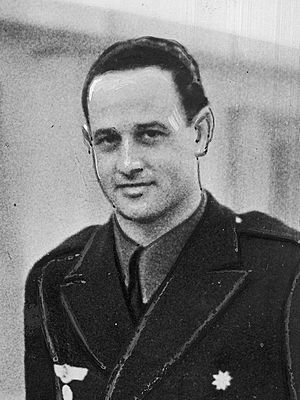Joaquín García Morato facts for kids
Quick facts for kids
Joaquín García-Morato
|
|
|---|---|
 |
|
| Birth name | Joaquín García-Morato y Castaño |
| Born | 4 May 1904 Melilla, Spain |
| Died | 4 April 1939 (aged 34) Griñón, Spain |
| Buried |
Málaga, Spain
|
| Service/ |
Air Force |
| Years of service | 1920–1939 |
| Rank | Captain |
| Commands held | Blue Patrol |
| Battles/wars | Rif War Spanish Civil War |
| Awards | Laureate Cross of Saint Ferdinand |
Joaquín García-Morato y Castaño, 1st Count of Jarama (4 May 1904 – 4 April 1939) was the leading Nationalist fighter ace of the Spanish Civil War. He is credited with 40 air victories, four gained while flying Heinkel He 51s and 36 with the Italian Fiat CR.32.
An accomplished prewar pilot, Joaquín García-Morato served in Morocco (fighting Abd el-Krim insurgents during the Rif War), excelled in aerobatics, and instructed instrument flying.
Spanish Civil War
He was on holiday in England when the Civil War broke out. Hastening home to join the Nationalist cause, he gained his first victory on 12 August 1936 in a Nieuport-Delage 52, shooting down one of three Vickers Vildebeest over Antequera. He then flew one of the first Heinkel He 51s received from Germany. Flying this aircraft, on 18 August, he shot down a Republican NiD 52 and a Potez 540. He downed another NiD 52 on 2 September. He then began flying an Italian Fiat CR.32, shooting down another NiD 52 on 11 September: it was his fifth victory.
Then he formed the Patrulla Azul ("Blue Patrol") of three CR.32 and during the early autumn 1936 he added six more aircraft of French manufacture, plus a British built Hawker Fury, to his score. He gained his 12th victory on 5 November (a Potez 540), followed by his first kill of a Soviet-built Polikarpov I-15 fighter. On 13 January 1937, he managed to shoot down two Tupolev SB-2 bombers - that outperformed the Fiat in terms of speed - attacking them from a superior height: they were his victories number 16 and 17. On 18 February, during the battle for Jarama, he was escorting three Junkers Ju 52 bombers, with his two fellow pilots of the "Blue Patrol", when 36 I-15 biplanes intercepted them. The Patrulla Azul attacked the Republican fighters in a climbing turn, breaking the enemy's assault. Morato hit a first I-15 that dropped away, in a tight spiral, trailing smoke. Immediately afterwards he avoided being hit by another enemy fighter that was chasing him and he hit another I-15: the pilot threw up his arms and collapsed in the cockpit. Then suddenly the Republican fighters dived away, while 21 Italian CR.32s were rushing to Morato aid. For his part in this battle, Morato was awarded the highest Spanish military decoration - the Laureate Cross of Saint Ferdinand. In July 1937, following a massive attack by Republican forces, in the Brunete sector, on the extreme left of the Nationalist Madrid Army Corps, some of the biggest air battles of the war raged. On the 14th, Morato squadron had a field day. Accompanied by Salvador, Aristides and Guerrero, he intercepted a squadron of Polikarpov R-Z Natasha biplanes escorted by a number of Polikarpov I-16s Rata. The Nationalist pilots dived through the fighter escort, that scattered in all directions, and attacked the R-Zs, shooting down five. Two of them were credited to Morato. On 24 December 1938, Morato had one of his more successful days: he was escorting, with his group, a number of Ju 52 and SM.79 bombers, when they spotted a formation of eleven R-Z "Natashas", escorted by Ratas, over Cap de la Serra. The Nationalist pilots dived to attack, and in few minutes they destroyed nine of the R-Zs. Three of the kills were credited to Morato.
Morato achieved 40 credited victories over Republican aircraft, gained in 1,012 hours of operational flying. The only time he was shot down was on 3 October 1937, by a novice pilot he was training.
Death
Shortly after the war, on 4 April 1939, he was performing low aerobatics for newsreel cameras, when his Fiat CR.32 crashed, killing him.
See also
 In Spanish: Joaquín García-Morato para niños
In Spanish: Joaquín García-Morato para niños

